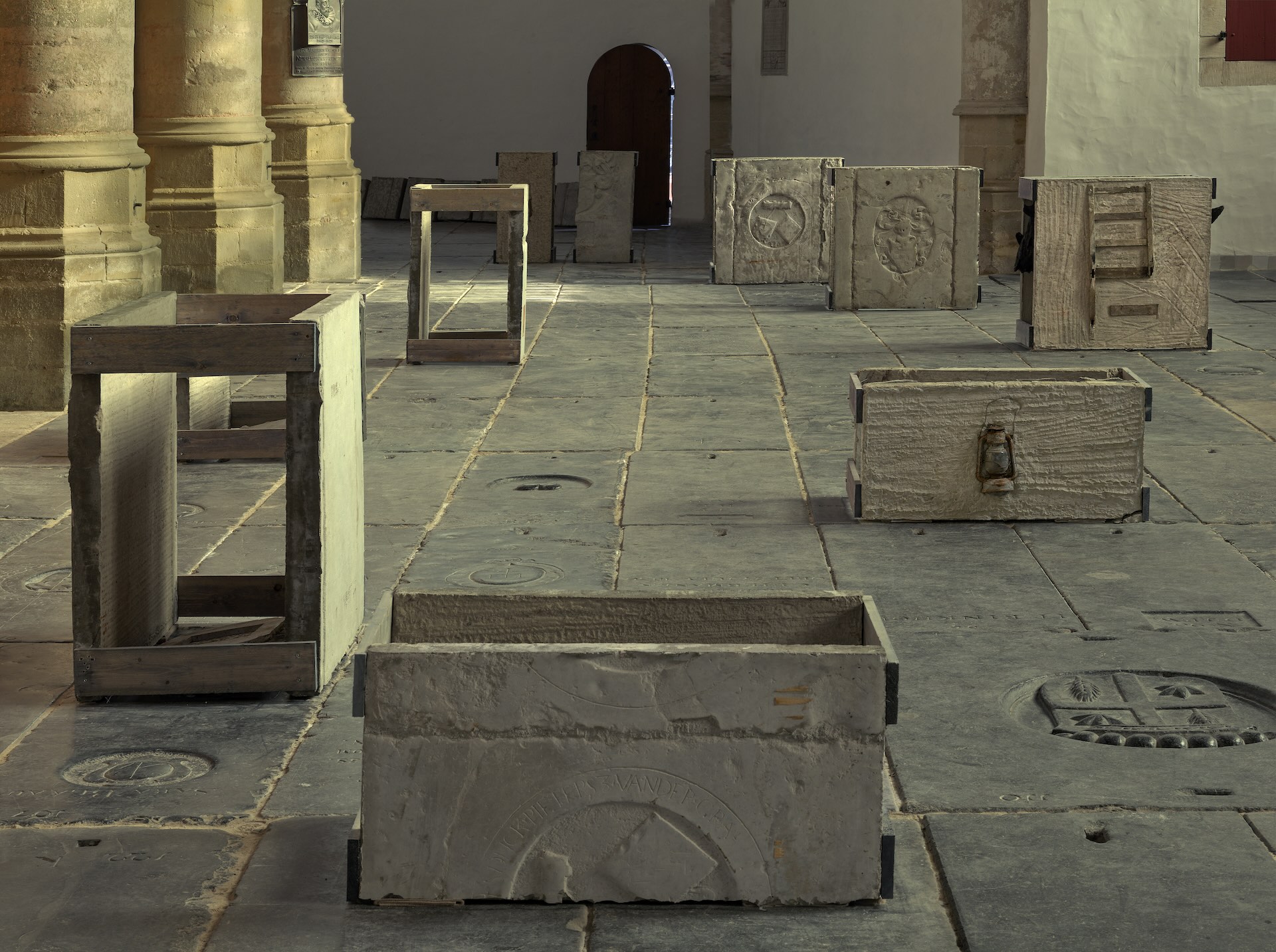The Oude Kerk is Amsterdam’s oldest building, a monument where past and present meet. But how does history live on? Since 2016, Oude Kerk has become a platform where contemporary art, music, and performance bring heritage to life. More than just showcasing work, the space preserves history and records what we value in the future through its exhibitions. Ahead of Post-Space on October 10th, we spoke with the Oude Kerk team and participating artists to explore how collective memory is shaped.
.jpeg)
Heritage in motion
Much like UNESCO World Heritage sites, Amsterdam’s Oude Kerk is recognised for its historical and cultural value. It is officially protected by the Netherlands’ Cultural Heritage Agency, ensuring its preservation for future generations. Besides being a protected monument, the Oude Kerk is, in a sense, a rehearsal space for what might come. Built starting in 1213 and consecrated in 1306, the church has served as a harbour chapel, a site of civic exchange, and today as an experimental platform for artists and musicians, adding new layers to its dense history.
As director Mariette Dölle puts it, ‘we like to experiment precisely at the intersection of tradition and innovation, of looking back and looking forward. The Oude Kerk is a building that has been under repair for seven centuries. That is a powerful contemporary message.’ By inviting artists to make site-specific work, the Oude Kerk opens new perspectives on the building, its history, and the stories we tell about ourselves.
Where we choose to host performances or display art is not a neutral decision. It signals what we value, what we want to elevate, and what histories we choose to inhabit. Often, we repurpose these tangible historical spaces either out of practicality, playfulness, or to subvert what no longer fits. For some, watching an art piece in a church feels like attending a dance event in a former war bunker. We stand in the tension between remembering the past and actively shaping the future.
Dölle continues: ‘The art of today is the heritage of tomorrow. Every exhibition at the Oude Kerk is treated as an archival intervention, with some spanning decades. In 2024, artist Navid Nuur created one hundred vases for the city, which are now kept inside the church. Beginning in 2025, one vase will be auctioned each year. In 2125, when the final vase leaves the chapel, the proceeds will fund an artist not yet alive. ‘We want to create space and time for multiple answers to the question of what may be of value for people, city, and society, now and in the future’, says Dölle. This is curation as timekeeping.
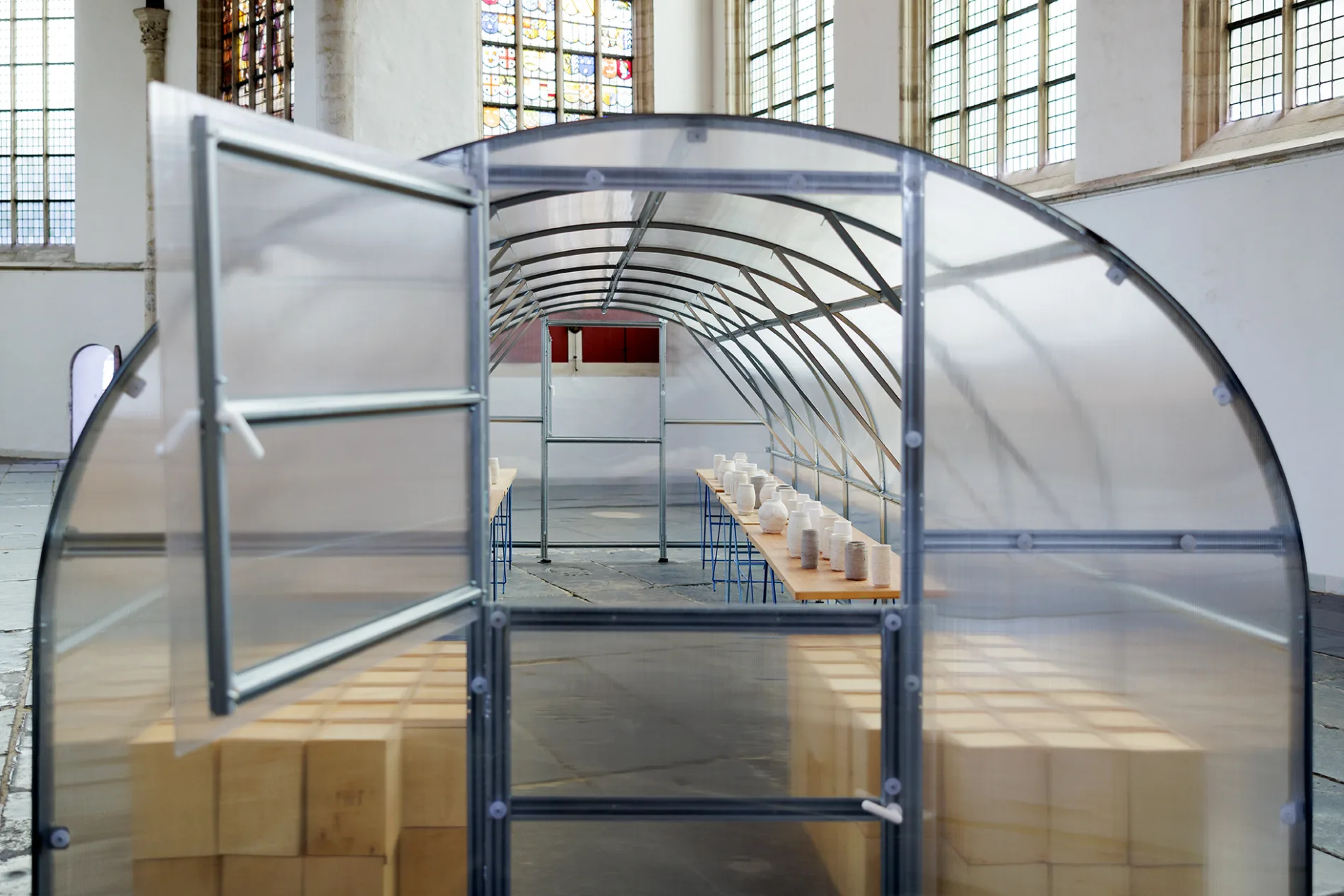
Activating the intangible
What’s perhaps less apparent is that cultural heritage has a vast intangible side to it. Think about the restoration of Notre Dame in 2019 after the fire struck the building. An estimated 846 million euros were pledged to rebuild the site. It is a testament to the church’s value that extends beyond its brick and mortar. It shows that restoring a monument is not just about preserving the building itself; it is also about how we remember the place and the stories it carries. It has the power to revive a community’s memory, pride, and sense of identity, especially after loss through conflict or climate disaster. Plus, besides the intangible impact, cultural heritage has an intangible dimension in itself (stories, traditions, music). For instance, Berlin’s techno culture - officially recognised as intangible cultural heritage in 2024 - demonstrates how music and communal experiences shape a city’s identity and collective memory. As Oude Kerk curator Marianne van der Zwaag explains: ‘Heritage is more than a collection of objects; it also consists of memories and absences. When artists work with these immaterial dimensions, new connections become visible and tangible that transcend time and space.’
One striking example is Adrián Villar Rojas’ Poems for Earthlings (2019), a soundscape installation in the church that no longer exists physically. Over eight hours, it layered recordings of whale sounds, dying languages, and mechanical hums to evoke a temporal and planetary consciousness. By making the work ephemeral, Villar Rojas highlighted the impermanence of sound – and, by extension, the fragility of intangible heritage. Visitors were immersed in an environment where memory and experience could not be preserved in objects alone, prompting reflection on what we value and why. ‘Every intervention adds a new layer to its already layered identity’, says Van der Zwaag. ‘Experimental art makes that stratification tangible through contrast, making voices and layers audible and visible that are often missing from official history. Temporary interventions thus become lasting traces in collective memory. Heritage is not fixed, but continually recharged through interventions, losses, and additions.’
This sense of recharging, rather than preserving untouched, leads to an important distinction: heritage versus archive. Heritage refers to what we recognise as valuable and actively pass on – a living tradition we inhabit, experience, and reinterpret. Archives denote what we preserve, record, and document – a consolidated memory of the past, often static and object-centred. At the Oude Kerk, we constantly move between the two: the building itself is heritage, protected and maintained, while artistic interventions serve as archives in and of themselves, drawing on the stories of the Oude Kerk. The question is not just about how we protect heritage, but how we choose to activate it.
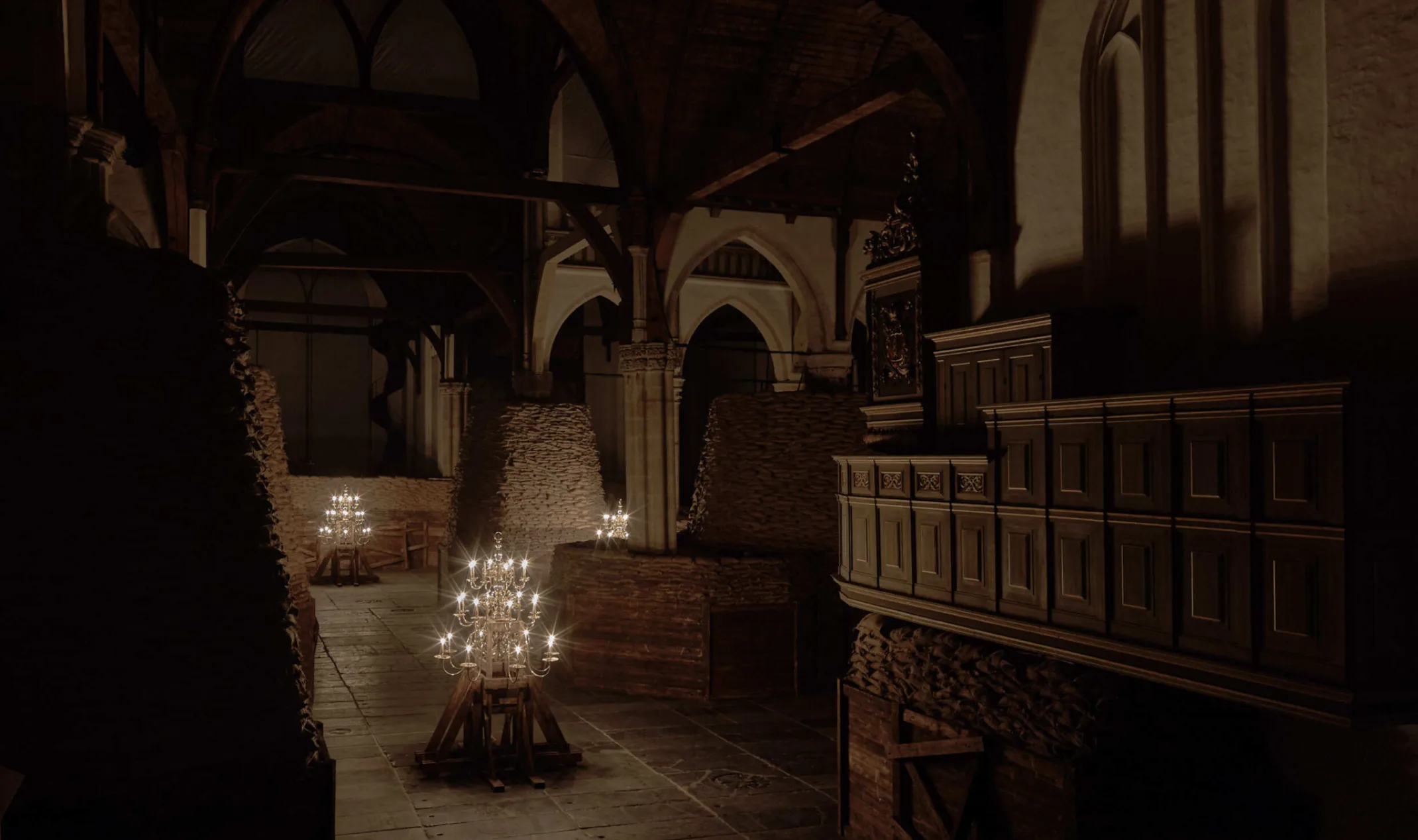
Rewriting the narrative
Why then does archiving and heritage preservation matter? French historian Michel Foucault critiqued archives as instruments of power, arguing that “the archive is not a passive repository but the first law of what can be said”. Heritage is therefore not a static container; it shapes the rules of discourse, determining which voices are preserved and which are silenced. This is not neutral: as Foucault writes, it is an “exercise of power”, in which “power is employed and deployed through a certain organisation of knowledge”. The very stones of a monument like the Oude Kerk act as a material archive, embodying the authority of the civic and religious powers that built and maintained it. Foucault’s insight compels us to ask not just what happened, but who has the authority to narrate what happened.
In its contemporary incarnation, the Oude Kerk becomes a stage for this interrogation, where artists engage in what Foucault might call “counter-memory,” unearthing silenced histories and challenging what is deemed sacred or negotiable. The curatorial team embraces this responsibility. Director Mariette Dölle explains: ‘In 2022/2023, Ghanaian artist Ibrahim Mahama created a moving site-specific work. He collected artefacts from Ghana’s colonial history – bales of jute sacks, train carriages, water jugs – and placed them bluntly in museums, engaging audiences worldwide in how a painful history continues to resonate today. Such an intervention in the Oude Kerk does not erase the church’s Christian past; it expands its capacity to hold multiple histories simultaneously.’ By situating Mahama’s work across the 3,000 m² of gravestones that form the church floor, the installation exemplifies counter-memory in both tangible and intangible ways – a deliberate overlay of histories in dialogue.
Rewriting the narrative
Why then does archiving and heritage preservation matter? French historian Michel Foucault critiqued archives as instruments of power, arguing that “the archive is not a passive repository but the first law of what can be said”. Heritage is therefore not a static container; it shapes the rules of discourse, determining which voices are preserved and which are silenced. This is not neutral: as Foucault writes, it is an “exercise of power”, in which “power is employed and deployed through a certain organisation of knowledge”. The very stones of a monument like the Oude Kerk act as a material archive, embodying the authority of the civic and religious powers that built and maintained it. Foucault’s insight compels us to ask not just what happened, but who has the authority to narrate what happened.
In its contemporary incarnation, the Oude Kerk becomes a stage for this interrogation, where artists engage in what Foucault might call “counter-memory,” unearthing silenced histories and challenging what is deemed sacred or negotiable. The curatorial team embraces this responsibility. Director Mariette Dölle explains: ‘In 2022/2023, Ghanaian artist Ibrahim Mahama created a moving site-specific work. He collected artefacts from Ghana’s colonial history – bales of jute sacks, train carriages, water jugs – and placed them bluntly in museums, engaging audiences worldwide in how a painful history continues to resonate today. Such an intervention in the Oude Kerk does not erase the church’s Christian past; it expands its capacity to hold multiple histories simultaneously.’ By situating Mahama’s work across the 3,000 m² of gravestones that form the church floor, the installation exemplifies counter-memory in both tangible and intangible ways – a deliberate overlay of histories in dialogue.
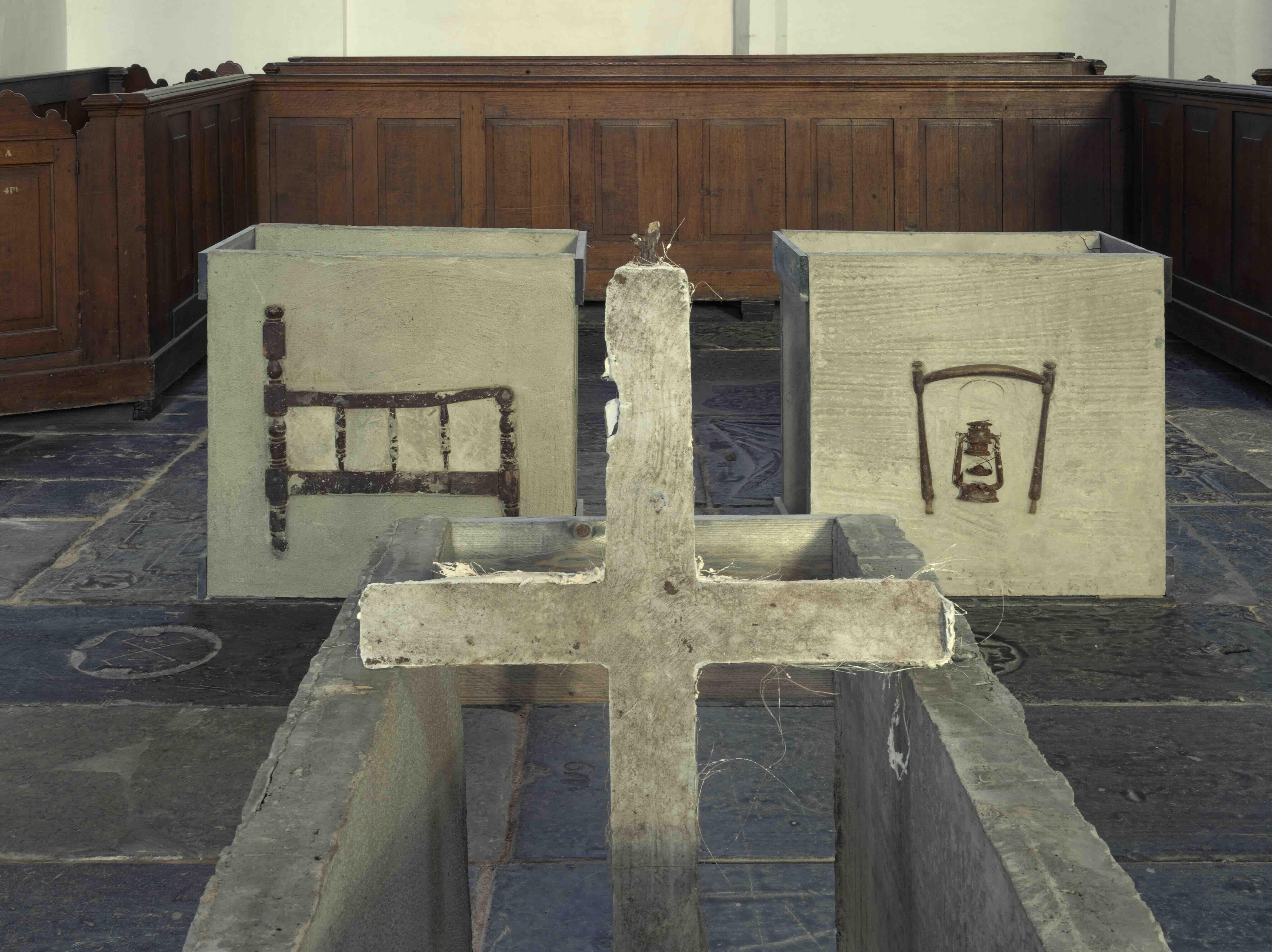
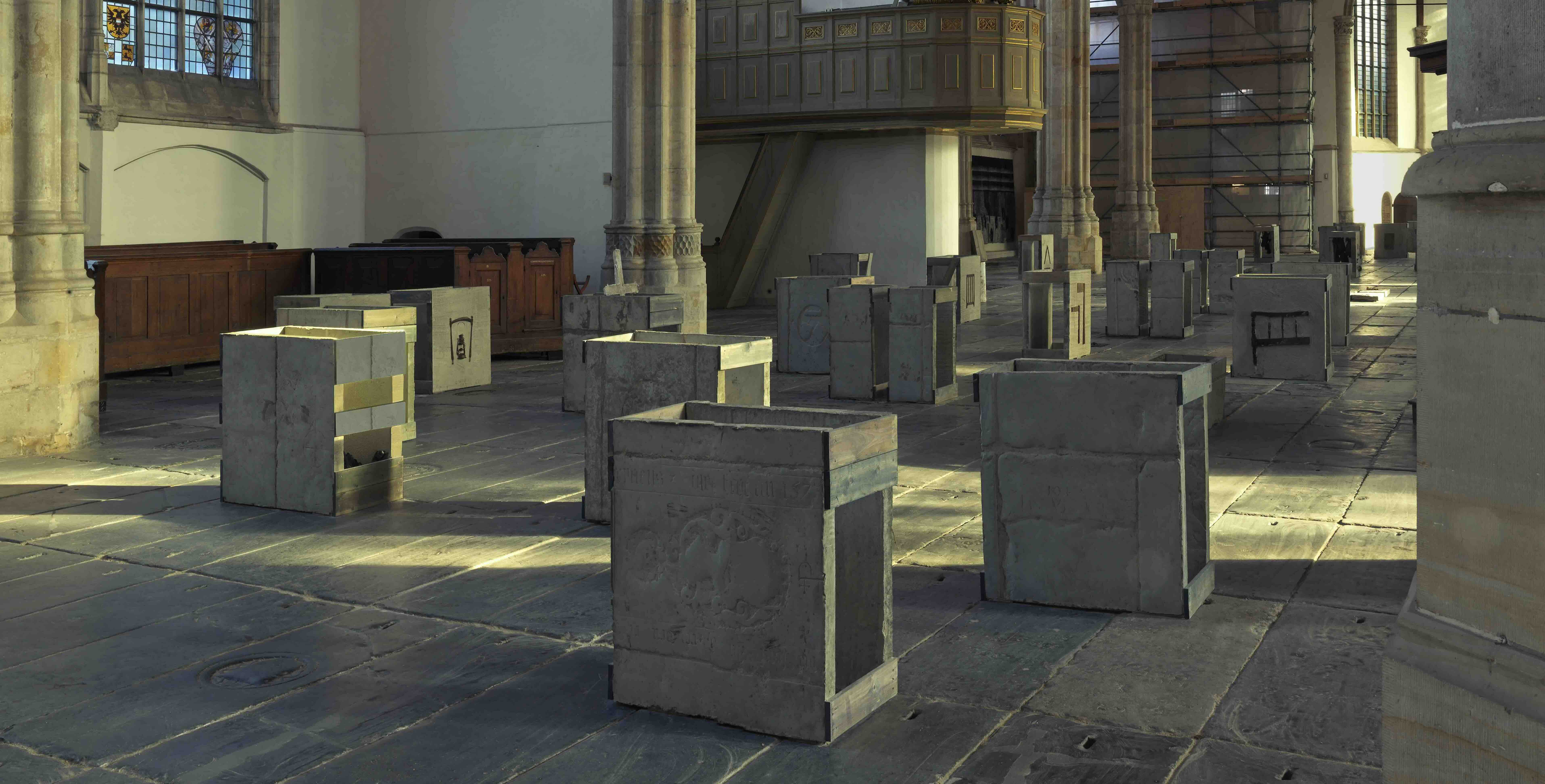
Bridging past and present
Another artist drawing on a location’s past is Korean artist Kimsooja, currently exhibiting at the Oude Kerk. In To Breathe – Mokum, she references the church’s role as a harbour sanctuary in the 15th and 16th centuries, where sailors dried sails, migrants registered marriages, and travellers prayed for safe passage. Kimsooja fills the space with bottari – textile bundles made from clothing donated by Amsterdam’s communities – each like luggage, reflecting the city’s long history of arrival, departure, and migration, and the diversity of its residents, now numbering over 170 nationalities. More than 44,000 window panes are covered with a transparent film that refracts sunlight into the full spectrum, creating shifting illuminations across ceilings, gravestones, and pillars, guiding our gaze and revealing the architecture anew.
In 2021, Susan Phillips’ installation The Fall responded to the legacy of Dutch composer Jan Pieterszoon Sweelinck by suspending pale green silos throughout the Oude Kerk, each containing a vocal part of a four-part harpsichord composition. Visitors moving through the church experienced the voices shifting in intensity, creating a layered soundscape that connected the church’s musical past with the present. The installation transformed the interior into a living archive, where sound enacted counter-memory and highlighted dimensions of history often absent from official narratives. The spatial arrangement of the silos guided visitors’ movement, prompting them to engage with the architecture while encountering overlapping traces of music, memory, and performance.
This temporal dialogue informs not only visual art but also live artistic practices, turning sound, movement, and performance into forms of real-time archiving.
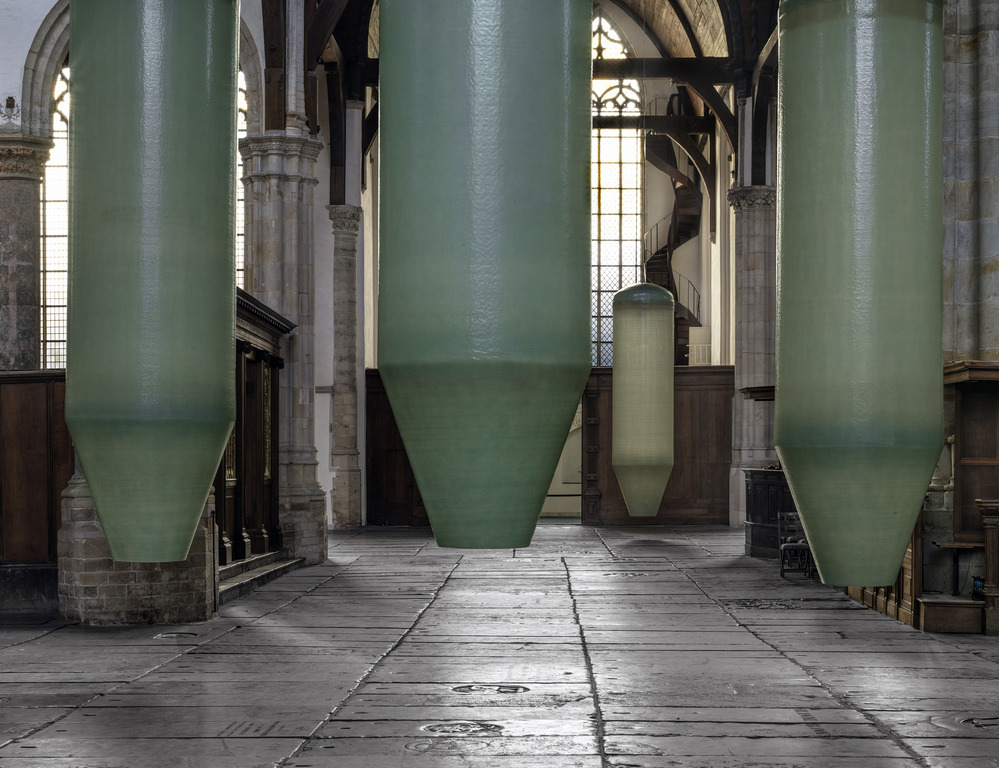
Performing the archive
‘From what I understand, the walking concerts originated in the late 16th century, when composer Sweelinck was organist of the Oude Kerk and played the organ there daily. This also happened outside of church services, so the public could walk in and out of the Oude Kerk and enjoy the music.’ Music curator Orpheu de Jong explains how Jan Pieterszoon Sweelinck (1561–1621) laid the foundation for public concerts at the Oude Kerk after the Reformation, establishing a precedent for archiving through live performance. Drawing upon these walking concerts, De Jong curates the Silence and Monuments series, as well as collaborations like Post-Space with Minimal Collective, where artists are invited not only to perform, but to join the dialogue with researchers before the event takes place.
Richard Skelton, a multi-instrumental artist currently living in rural Ireland, creates music deeply informed by place and history. In addition to his music, Skelton co-runs Corbel Stone Press, an Anglo-Canadian small press specialising in works focused on landscape, mythology, and esoteric philosophy. His practice often involves subtle gestures, such as burying instruments in soil, allowing natural processes to shape sound, or translating environmental phenomena into composition. During a residency in Iceland, for example, he transformed glacial recession data into an improvised composition of sine waves, distortion, and feedback, resulting in his Towards the Frontier release. Reflecting on his upcoming performance at the Oude Kerk, he explains: ‘From my previous experience of playing in resonant spaces, the space itself becomes a participant, a co-performer. I’ll be interested to spend some time in the church before the performance, listening to how it responds. I’ll also be taking some time to research the building’s history with the hope of finding something that I can focus on, and incorporate into my performance. I imagine that I’ll play more slowly, to allow space for the building to respond.’
Kenyan sound artist Joseph Kamaru (otherwise known as KMRU) is known for his ongoing dialogue with history and music within his work. He tells us: ‘Sound can act as memory carriers of cultures. From past generations, sound has always been the foreground of preservation and sheltering of stories and knowledge.’ Listening to his Temporary Stored II album, which is created while accessing the sound archive of the Royal Museum of Central Africa in Tervuren in Belgium, one can trace back the memories and stories of the past, hearing voices, instruments, and field recorded atmospheres of times long-gone, all processed within Joseph’s so called ‘shelter of care’, which he uses as description for his personal archive. Berlin-based artist Sasha Zakharenko, mostly known as Perila, describes it rather as a feeling than a format or act: ‘I’m deeply affected by spaces – sometimes a room or a sound pulls up memories I didn’t know were still inside me. Nostalgia arrives like temperature. You don’t choose it – it washes over you.’
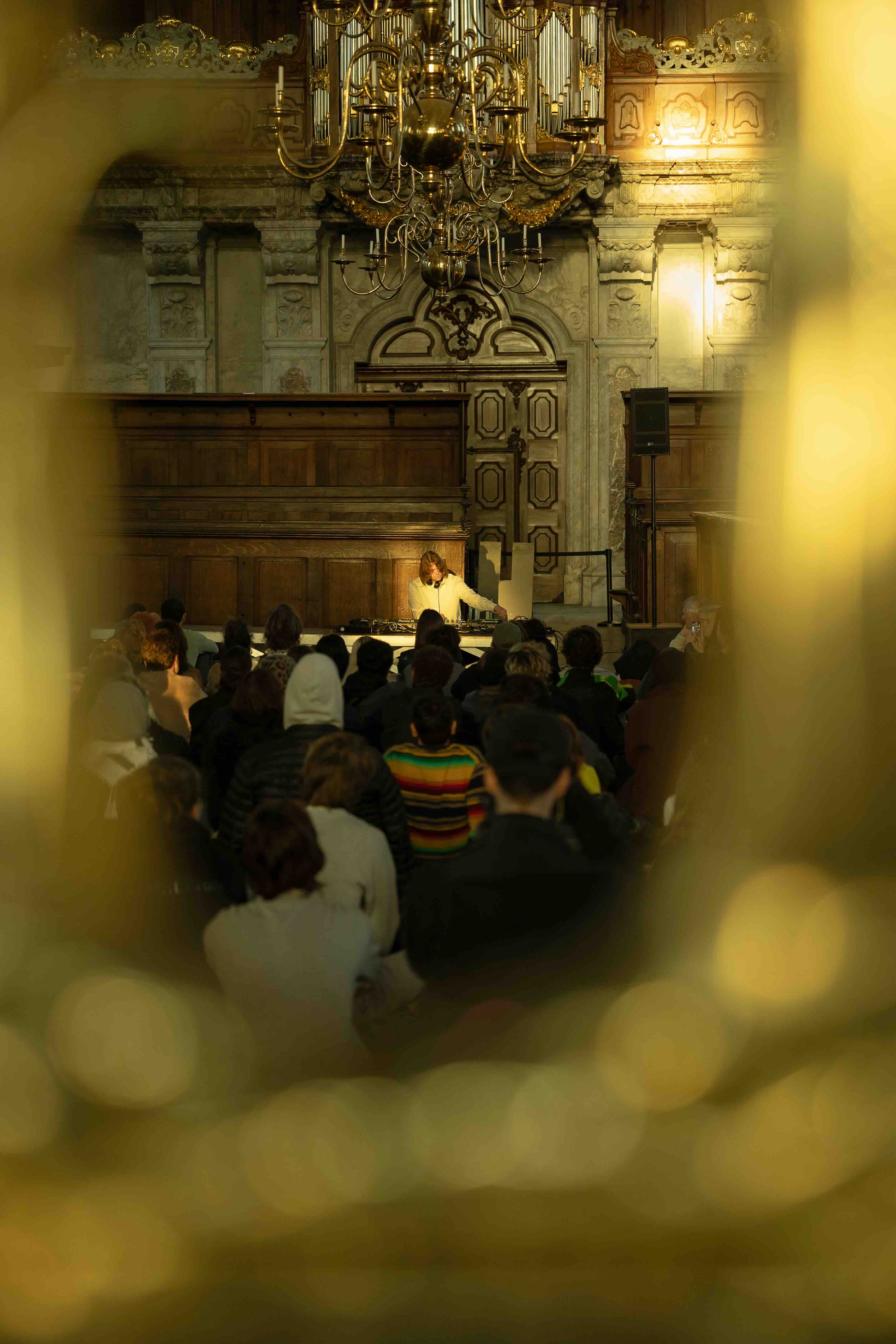
The archive of self
These reflections show how archiving extends beyond institutions and enters the personal and bodily realm. Memory lives not only in collections or catalogues but also in sensations and responses: a chord progression that tightens the chest, a sound that summons forgotten images.
Amsterdam-based Loek Frey explains this direct emotional response he translates within his work: ‘Although I like to approach music with as few rules as possible, I’m very sensitive to my surroundings. They act like the “ink” that fuels my creative process. Whenever I listen back to a track or project, I immediately remember the place where I created it. During live performances, I always leave room for a jam channel, allowing me to improvise directly based on what I feel within the space’. Berlin-based DJ and producer Emika Elena echoes this personal experience of exchange: ‘I would like the audience to experience heritage as something alive through sound – feeling history breathe and connecting with the present moment through the music’.
For Skelton, archiving begins in the personal and the mundane. ‘In a strange way, it’s only through performing the mundane activities of day-to-day life that the deeper qualities begin to emerge. At least, that’s how I’ve experienced it.’ He explains how these personal acts of archiving subtly find their way into his work: ‘Many of the gestures I’ve incorporated are ways of investing a process with meaning, and if something is meaningful, then it’s memorable. So, in this sense, ritual can be seen as an archival process,’ he explains. ‘Often these actions remain invisible in the final recording, creating a partition between private and public domains. This is where writing is useful, because it can offer insights to the listener. This can be direct, in the form of commentary, or oblique, through the giving of titles to recordings.’ It’s his attentive engagement with everyday rituals and the surrounding world that turns his compositions into intimate records of memory.
It seems that archiving and heritage play a deeper and more frequent role in our lives than we might imagine at first sight. While institutional archives concern restoration and documentation, the artistic and personal archive is more intimate. In this sense, we are all carriers of archives, continuously shaping them through our encounters with sound, space, and emotion. Think about it: a scent that drops you back twenty years. A chord progression that makes your chest tighten before you know why. The body keeps record long after the mind forgets. In this sense, we’re all the carriers of archives. It is not limited to basements, catalogues, or glass cases. Most archives don’t even know they are archives. A record collection at home. A box of photographs under a bed. A playlist saved for a particular breakup. A voice note you could not bring yourself to delete. These are acts of selection, and selection is authorship. We all perform it. Artists simply do it in public. Where some preserve memory privately, artists will materialise it in sound, fabric, architecture, or gesture.
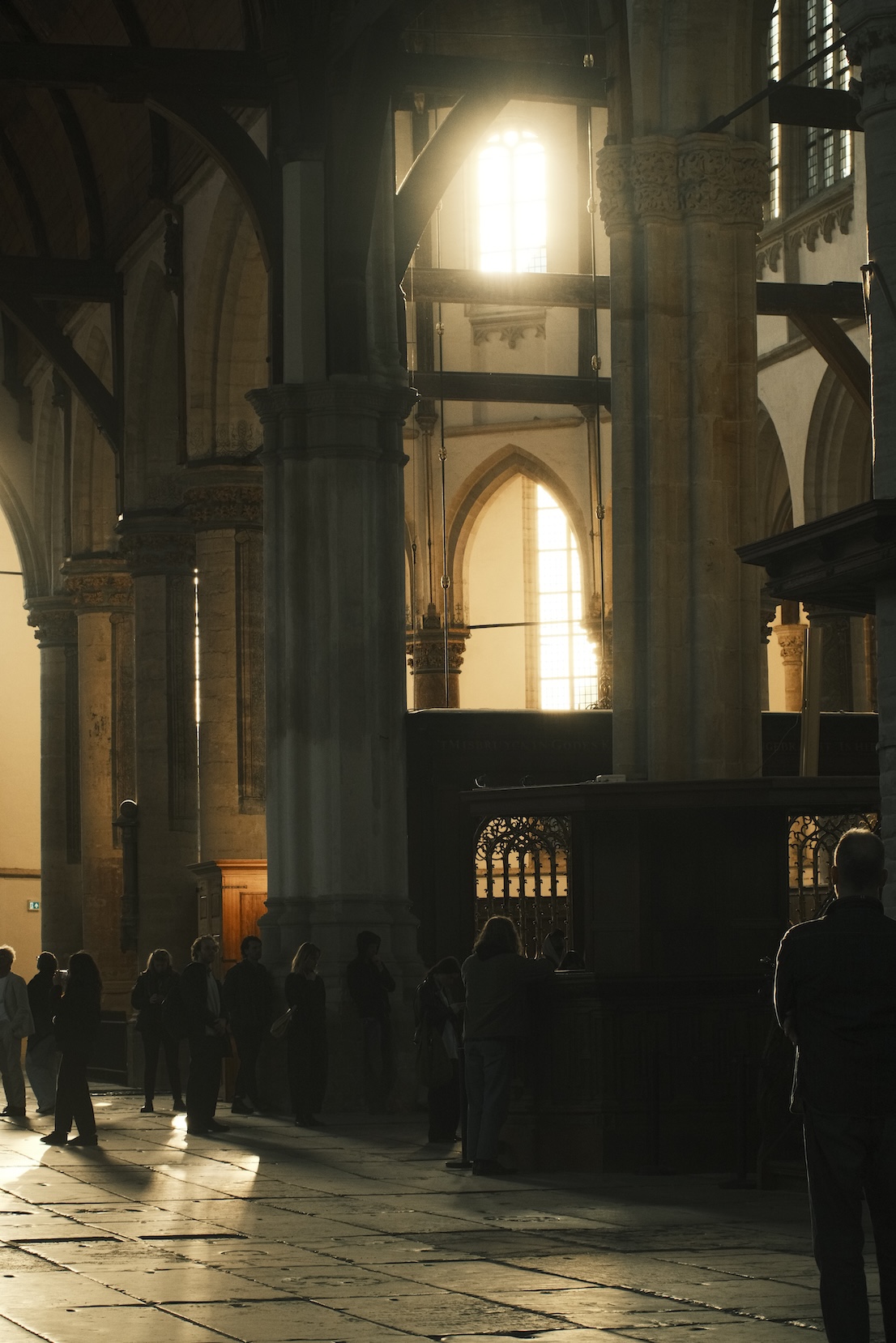
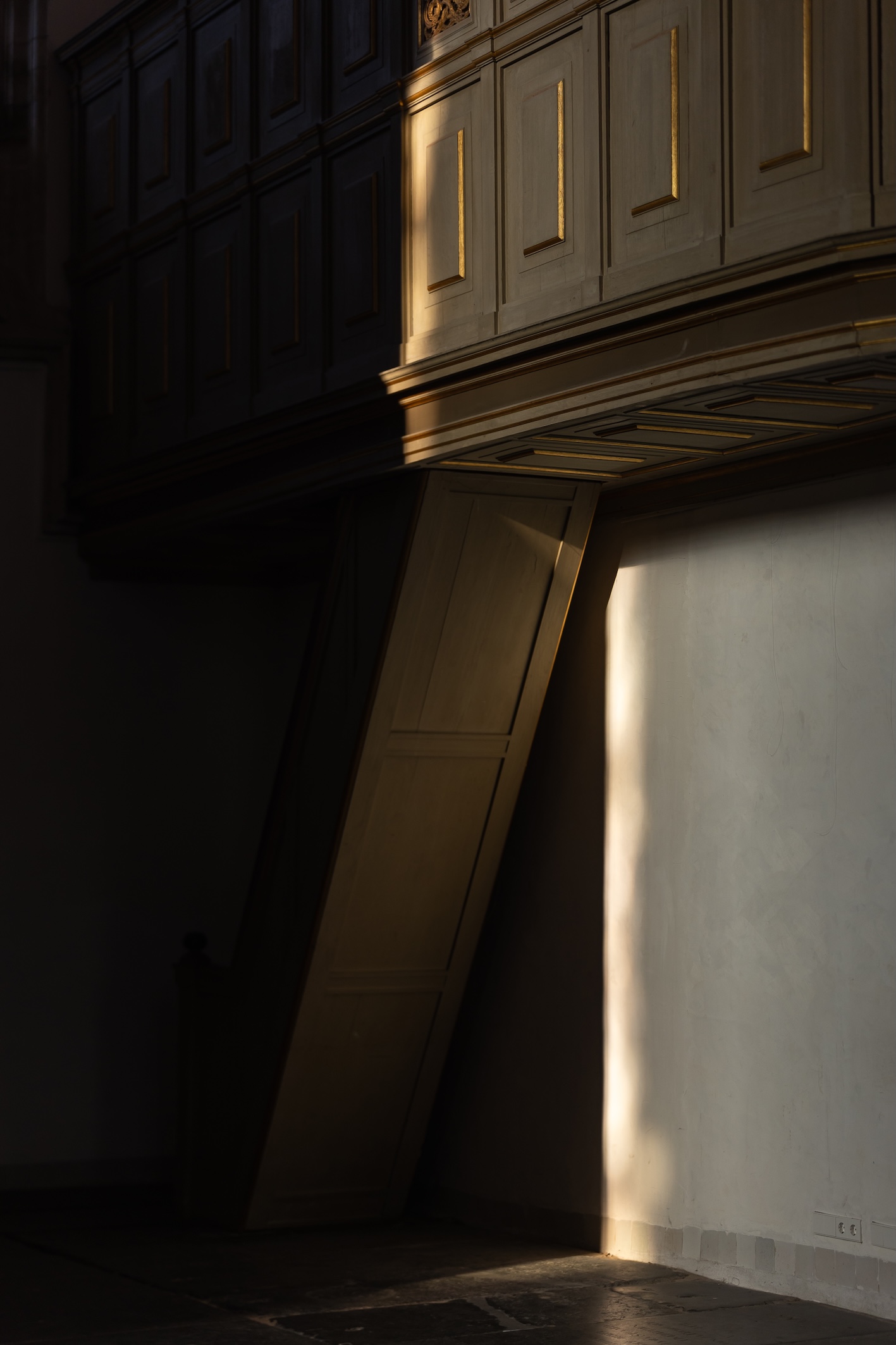
Co-creating future archives
However, in today’s fast-moving era, the question is no longer how we preserve the past, but how we record the present fast enough for the future to find it. Oude Kerk is aware of the constantly shifting dynamics of how heritage is kept and passed on. At the moment, the team is working on a new digital project, Open Archive, which will serve as an open network to interact with the history and works at hand. ‘Methods and possibilities of archiving will undoubtedly change, but the principle of an open and dynamic way of archiving remains crucial. This is what we are now attempting with Open Archive - approaching heritage as a network, fluid and multiple - one that in the future can serve as a counterbalance to limited, linear, or exclusive forms of historiography’.
At the Oude Kerk, institutions, artists, and audiences alike are becoming recorders, consciously or not. From century-spanning gestures like Navid Nuur’s 100-year vase relay to the upcoming launch of Open Archive, it becomes clear that archiving is not passive storage, rather active participation. It’s about what we choose to remember and how we shape our memory. As van der Zwaag reflects, ‘I see the future of curating as a form of attentive listening: to the space, to the history, to the voices still to come, to the voice of the artist.’ Heritage at the Oude Kerk is co-authored in real time, where every intervention, sound, and visitor shapes the future of the archive together. Van der Zwaag adds: ‘The word “curator” literally contains the Latin “curare” – to care for. Curating is both intervening and caring…Every archive is a representation – and therefore always a construction.’
In our next piece, we will dive deeper into the future of archives and memory, exploring the role of technology at the intersection of heritage and art – and what this means for the Open Archive of the Oude Kerk.
Join us on October 10th at the Oude Kerk, where Kantarion Sound will set up a site-specific system for a night of listening, featuring Emika Elena (DJ), KMRU (Live), Loek Frey (Live), Perila (Live), and Richard Skelton (Live). Doors open at 19:30, and the programme runs from 20:00 to 01:00 – get your tickets here.
Supported by Amsterdams Fonds voor de Kunst
